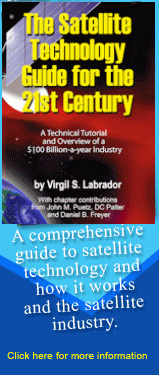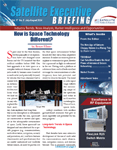The Satellite Industry in Transition
by Elisabeth Tweedie
Los Angeles, Calif., October 10, 2021--As we are all aware the satellite industry is in a state of flux, maybe a state of transition. The low earth orbit (LEO) constellations have been grabbing headlines for several years now, and many of us, have pointed to the lessons of the 1990s and predicted that few, if any of them would last long enough to become viable businesses. And that still may be the case.
 However, right now, things are looking promising for at least two or three of the many current contenders. After being bailed out by the British government and Bharti, OneWeb reemerged from bankruptcy and has gone on to attract additional investors and launch more satellites; it now has 322 of the initial constellation of 648 in-orbit, and is intending to start service north of 50 degrees later this year. Starlink, from SpaceX is further ahead and now has 1,700 satellites launched, and is already in beta service with over 100,000 customers. According to Bret Johnson, CFO of SpaceX, Starlink also has a backlog of over 500,000 customers, waiting for the ground terminals. However, the full constellation is intended to be around 42,000 satellites, although it is believed that full global service could be provided with around 10,000, meaning that either way, in terms of reaching the full constellation, it’s further behind. After a C$1.44 Billion injection from the Canadian government, Telesat has now secured most of the funding needed for its Lightspeed constellation, and plans to start initial launches for its constellation of 300 LEO satellites next year.
However, right now, things are looking promising for at least two or three of the many current contenders. After being bailed out by the British government and Bharti, OneWeb reemerged from bankruptcy and has gone on to attract additional investors and launch more satellites; it now has 322 of the initial constellation of 648 in-orbit, and is intending to start service north of 50 degrees later this year. Starlink, from SpaceX is further ahead and now has 1,700 satellites launched, and is already in beta service with over 100,000 customers. According to Bret Johnson, CFO of SpaceX, Starlink also has a backlog of over 500,000 customers, waiting for the ground terminals. However, the full constellation is intended to be around 42,000 satellites, although it is believed that full global service could be provided with around 10,000, meaning that either way, in terms of reaching the full constellation, it’s further behind. After a C$1.44 Billion injection from the Canadian government, Telesat has now secured most of the funding needed for its Lightspeed constellation, and plans to start initial launches for its constellation of 300 LEO satellites next year.
Changing Players
The change in the industry, however goes deeper than different orbital locations. The players are changing. For many years now, the industry has been dominated by a few large well-known names: SES, Intelsat, Eutelsat, Telesat, on the operator side, Arianespace, Lockheed and ULA on the launch side, while ground systems were dominated by iDirect, Comtech, Newtec and Gilat. There was also, never any shortage of grey hair amongst the – predominantly male – speakers on stage at conferences. Now, as already mentioned, OneWeb and Starlink are grabbing attention, as are Blue Origin and Virgin Orbit. SpaceX’s first Falcon 9 commercial launch was only in 2012 but it’s fair to say that it is now an established player. On the ground side it has been more a case of consolidation, accompanied by new software players such as AWS entering the market. As for the grey hairs, I didn’t count at Satellite 2021, but it’s fair to say that many of the speakers and attendees, were lacking those, and around 20% of approximately 300 speakers were ladies.
Grey hairs apart, these change in the industry were clearly reflected in the delayed Satellite 2021 held last month. Instead of the usual opening session with the key geostationary (GEO) operators, speakers for the first session included only one GEO operator, Arabsat. The other three were all LEO operators: Iridium, SpaceX and OneWeb. Moderating the panel, Christopher Baugh, President, NSR pointed out that: “the industry doesn’t have a supply problem, it has a demand problem.” In the latest edition of “Global Satellite and Launch Markets,” NSR forecasts that over the next 10 years, satellite manufacturing and launch order volumes will reach nearly 24,700. A far cry from the 10 to 20 commercial geostationary satellite orders per year, that used to be the norm. Euroconsult in the latest edition of its report, “Satellite Connectivity and Video Market, “forecast that the total global capacity will expand from 3.7Tbps in 2020 to 23 Tbps in 2022 and over 50 Tbps by 2026. Last year 97% of capacity added came from Non-Geostationary Satellites (NGSO). Given this potential for serious over-supply, it is hardly surprising that the one thing that all the panelists were agreed upon, and articulated by Neil Masterton, CEO, OneWeb, was the necessity of meeting customer needs at “a price point that makes sense to them.” Presumably, also at a price point that that closes the business case. Quite a challenge, given the billions invested upfront in the LEO constellations.
Messaging Problem
| "...The industry may also have a messaging problem, as well as an oversupply problem... " |
The industry may also have a messaging problem, as well as an oversupply problem. OneWeb and Starlink are getting so much mediaattention at the moment, that some customers are getting confused about the continued relevance of GEO systems. Hadi Alhassani, VP and Chief Strategy Officer, Arabsat commented that this confusion is leading to customers “not committing to any service because they don’t want to bet wrong and end up with a defunct operator.” That hesitation is understandable, given that switching to a LEO system would not only involve working with new suppliers and partners, it would also involve an investment in new ground systems.
The ideal solution of course, would be an integrated terminal that could access both Non-Geostationary Satellites (NGSOs) as well as GEOs. This point was made more than once on different panels during Satellite, being mentioned by both Tom Choi, Executive Chairman, Airspace Internet Exchange, and Karl Fuchs, SVP Technology, iDirect Government.
For some business users, this dream is about to become reality. In October, SES is scheduled to launch the first three satellites of its next generation Medium Earth Orbit (MEO) constellation, O3b mPOWER. In the same month it will also launch SES-17, its advanced GEO satellite. These launches mark the first step in the integration of SES’ multi-orbit fleet, with the ultimate aim of creating a totally interoperable network. O3b mPOWER and SES-17 both use a new software control system, known as ARC – Automatic Resource Controller. ARC manages dynamic changes in real-time by controlling both the ground and space resources, (satellite payload, gateways and user terminals). The software has been designed to leverage the flexibility of digital payloads by concentrating the power in different beams as and when needed, as well switching seamlessly between SES-17 and O3b mPOWER, depending on the latency requirements of the application. Controlled by ARC, the ground terminals for O3b mPOWER seamlessly switch between orbits as and when needed. Cruise ships will be the first segment to take advantage of this flexibility.
Ground Segment
While incredible changes have been taking place in space, the ground segment has generally lagged behind in terms of innovation, particularly with regard to developing technology to leverage the increased power and flexibility of new satellites. Promulgating this issue, is the fact ground systems lack interoperability, due to the prevalence of proprietary standards. Not only does this mean that customers can be “locked-in” to a particular supplier, it also makes integration with terrestrial systems more challenging. AWS has recently entered the ground segment with its Ground Station as a Service (GSaaS), a fully managed service, enabling users to control the satellite communications as well as process data and interface with Cloud and terrestrial services, and Paul Mattear, Principal Business Development Manager for AWS, emphasized this lack of interoperability saying, “One of the issues that we have with ground infrastructure is a lack of standards across the board.”
This may be about to change. In the last month, two separate industry groups have been formed with the aim of establishing interoperability between space and terrestrial network systems. The Digital Intermediate Frequency Interoperability (DIFI) Consortium was formed under the auspices of the IEEE Industry Standards and Technology Organization (ISTO), and includes Intelsat, Kongsberg Satellite Services, Kratos Defense and Security Solutions, Kymeta, Microsoft, Hawkeye 360 and the US Navy. The stated mission of this group is “to enable the digital transformation of space, satellite, and related industries by providing a simple, open, interoperable Digital IF/RF standard that replaces the natural interoperability of analog RF signals and helps prevent vendor lock-in.”
Members of the other consortium, the Digital Interface Standards Working Group (DISI) currently include Communications & Power Industries (CPI), DataPath, Datum Systems, Gilat Satellite Networks, SES, ST Engineering iDirect and Wavestream. This group is focusing on digitizing the interface between the modem and RF components, so as to take full advantage of developments in virtualization, cloud computing and network virtualization technologies, as well as improve the performance and scale of satellite hub, gateway and modem equipment. In an open letter to the industry, Frederik Simoens, CTO ST Engineering iDirect said: “We need to make sure that when we output a digital signal, it can talk to as many vendors as possible, so we’re not limiting ourselves to only a few selected vendors that can interoperate with the signal. Once we know that everybody talks in the same language, I think the move toward full virtualization of the modem infrastructure will become much easier.” In the same open letter, Tom Cox, VP Business Development and Sales, Wavestream, commented that if the industry isn’t able to become more agile to keep pace with all the changes both on the ground and in space, it would make it more difficult for integrators to sell satellite solutions versus terrestrial solutions.
According to ST Engineering iDirect, DISI is reaching out to the DIFI, the other industry group to see how the two could work together.
If either or both of these groups can succeed in steering the different players in the ground segment towards common standards, we could start to see more economies of scale in ground equipment which in turn should help both speed development and lower the price of the ground component, which in turn may help the operators close their business case. As Stuart Daughtridge, VP Advanced Technology and Business Development, Kratos Defense and Security Solutions succinctly stated: “If your ground segment can’t support it, it doesn’t matter how great your satellite is.”
--------------------------------------------
 Elisabeth Tweedie has over 20 years experience at the cutting edge of new commmunications entertainment technologies. She is the founder and President of Definitive Direction (www.definitivedirection.com), a consultancy that focuses on researching and evaluating the long-term potential for new ventures, initiating their development, and identifying and developing appropriate alliances. During her 10 years at Hughes Electronics, she worked on every acquisition and new business that the company considered during her time there. She can be reached at etweedie@definitivedirection.com
Elisabeth Tweedie has over 20 years experience at the cutting edge of new commmunications entertainment technologies. She is the founder and President of Definitive Direction (www.definitivedirection.com), a consultancy that focuses on researching and evaluating the long-term potential for new ventures, initiating their development, and identifying and developing appropriate alliances. During her 10 years at Hughes Electronics, she worked on every acquisition and new business that the company considered during her time there. She can be reached at etweedie@definitivedirection.com





